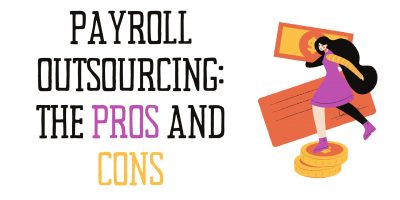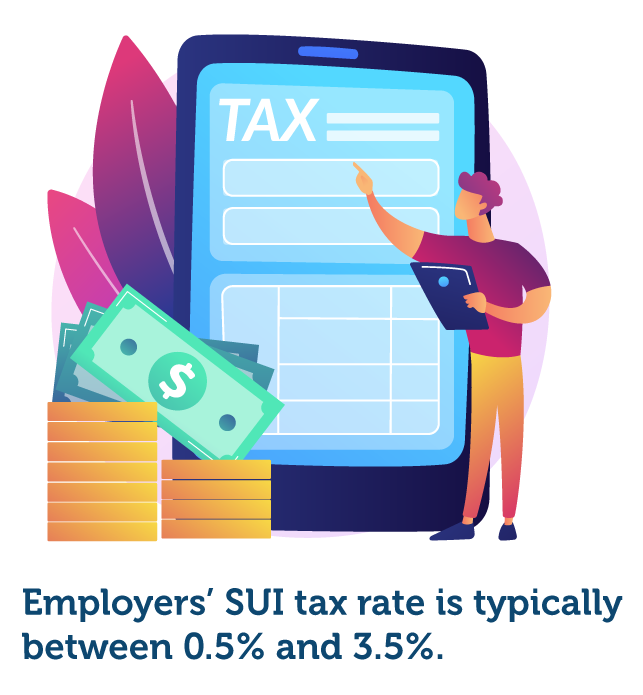
Payroll Outsourcing: The Pros and Cons
Explore the advantages and disadvantages of payroll outsourcing to evaluate if it is the right solution for your business.

According to recent unemployment statistics, about 1.2 million U.S. workers were laid off or discharged in April this year. And the employees who lose their jobs for reasons that are out of their control could qualify for the state unemployment insurance program.
The state unemployment insurance was created in 1953 to support the basic needs of unemployed workers until they find a new job. That’s why the benefits they receive are temporary.
Typically, the period over which one can receive compensation is around 26 weeks, which is about half of the previous wage base, on average.
Before the pandemic, the trust fund for this program had $72.5 billion.
However, the COVID-19 restrictions changed the working conditions, and many people were fired and unable to work. Hence, the trust funds were drained, and in 2021 40 states and territories remained below the recommended solvency level.
But the situation is improving in 2022, with 31 states meeting the minimum solvency level, and the balance is now at almost $40 billion and constantly increasing.

Simply put, state unemployment insurance, often referred to as SUI, is a state program funded by taxes paid by employers that support workers who get discharged because of layoffs or other uncontrollable reasons.
Thus legally, people who quit their jobs voluntarily or get fired are not eligible to apply for these benefits. SUI covers only those who are not responsible for becoming unemployed.
The basic unemployment insurance program is in the hands of the states; however, the US Department of Labor supervises their work to ensure compliance.
Unemployment insurance is a joint program between individual state and federal governments.
As such, each state has the freedom to design a program, including the eligibility requirements and the level of benefits, but it must follow guidelines specified by federal law.
To receive the benefits, workers must meet specific criteria and pass the application process. The basic program gives cash stipends for up to 26 weeks, about half of the worker’s average pay.
However, suppose the state’s unemployment situation is dramatically worsening.
In that case, depending on the unemployment rate and insurance laws, some workers might be eligible to apply for the extended benefits program, which provides additional compensation for 13 to 20 weeks.

SUI is funded by specific federal and state employer payroll taxes. It means employers are obliged to pay these taxes, not employees, except in Alaska, New Jersey, and Pennsylvania.
In every state, employers must pay state and federal unemployment taxes if in any quarter of the year they pay employee wages totaling $1,500 or if they had at least one employee for any day of the week during 20 weeks in a year regardless of whether the weeks were consecutive.
Since some state rules, laws, and procedures differ from the federal ones, employers should contact the state workforce agencies to find the proper requirements for paying taxes.
To qualify for unemployment benefits, a person has to meet specific criteria.
Each state has its guidelines, but generally, applicants must comply with two primary conditions:
Applicants can learn about the other necessary requisites through the state workforce agencies.
To apply for unemployment insurance, applicants must determine whether they meet the eligibility criteria. After establishing that, they need to file a claim with the SUI program in the state where they worked.
There are three options to file a claim: in person, via phone, or online.
The proper channel to do this depends on the state, as some states might require filing online or in person.
Whether they live in the same state or not, workers receive benefits from the state where they worked. The two variables of the benefits are the number of weeks they last and the weekly amount.
While some states provide benefits for the same length of time to every unemployed person, most states decide on the number of weeks depending on the worker’s amount of earning previously, whether they earned money in each quarter that makes up the base period, and how the amounts were distributed during the base period.
Most states provide benefits for a maximum of 26 weeks, but some workers are eligible for less than that because of uneven earnings or short working time. According to state laws, typically, the benefits cover about half of the claimant’s previous salary.

Depending on the state and its rules and regulations, state unemployment insurance is paid weekly or bi-weekly.
Regarding the amount received, in 2019, the average benefits per week were $378. However, each state has its different limits and averages. For instance, in the same year, the maximum average weekly amount was recorded in Massachusetts at $555, whereas Mississippi paid the least at $213.

Every state has the freedom to design its unemployment insurance program.
Thus, the eligibility requirements and the benefits level differ from state to state. However, the funding of the programs comes from state and federal taxes.
Regarding state taxes, every employer has to pay a payroll tax, also known as SUI tax, which is one way to fund the programs.
Employers’ SUI tax rate is typically between 0.5% and 3.5%.
However, depending on how long the employer works, it can go up to 11% in some states. What is important to point out is that the tax rate and the wage base are variable and can change annually.
Current information about tax rates and taxable wage base is available at the US Department of Labor.
In addition to SUI taxes, employers must also pay the Federal Unemployment Tax Act, also called FUTA. Employers pay this tax by filing an annual IRS Form 940. This tax covers the costs of administration of the benefits in the states. Additionally, it covers half of the extended unemployment benefits costs and provides funds from which states can borrow to pay benefits if needed.
To calculate the FUTA taxes, the employer should multiply 6.0% times the taxable wages. A taxable salary is the first $7,000 in wages paid to each employee yearly. If an employer regularly pays its state unemployment taxes, they can get an offset credit of up to 5.4%. The FUTA rate for states not subject to a FUTA credit reduction is generally 0.6% or a maximum of $42 per employee.
To gain greater insight into the difference in the length of benefits, the average weekly amount, and the highest and lowest possible weekly amounts, check out the table below. The data is shown by arranging the states alphabetically for easier browsing.
State | Maximum Benefits Length (weeks) | Average Weekly Benefit | Highest Possible Weekly Benefit | Lowest Possible Weekly Benefit |
Alabama | 26 | $255 | $275 | $45 |
Alaska | 26 | $287 | $370 | $56 |
Arizona | 20 | $236 | $240 | $187 |
Arkansas | 16 | $244 | $451 | $81 |
California | 26 | $303 | $450 | $50 |
Colorado | 26 | $399 | $649 | N/A |
Connecticut | 26 | $338 | $667 | $75 |
Delaware | 26 | $260 | $400 | $20 |
Florida | 12 | $236 | $275 | N/A |
Georgia | 20 | $273 | $365 | $55 |
Hawaii | 26 | $472 | $648 | $5 |
Idaho | 20 | $320 | $414 | N/A |
Illinois | 26 | $353 | $505 | N/A |
Indiana | 26 | $255 | $390 | $50 |
Iowa | 26 | $373 | $493 | $73 |
Kansas | 26 | $375 | $488 | $122 |
Kentucky | 26 | $322 | $560 | $39 |
Louisiana | 26 | $192 | $247 | $101 |
Maine | 26 | $322 | $462 | N/A |
Maryland | 26 | $359 | $430 | $50 |
Massachusetts | 30 | $473 | $855 | N/A |
Michigan | 20 | $322 | $362 | $209 |
Minnesota | 26 | $410 | $762 | N/A |
Mississippi | 26 | $196 | $235 | $30 |
Missouri | 20 | $251 | $320 | N/A |
Montana | 28 | $382 | $552 | $163 |
Nebraska | 26 | $321 | $440 | N/A |
Nevada | 26 | $366 | $469 | N/A |
New Hampshire | 26 | $281 | $427 | $32 |
New Jersey | 26 | $426 | $713 | N/A |
New Mexico | 26 | $324 | $484 | $90 |
New York | 26 | $353 | $504 | $172 |
North Carolina | 20 | $236 | $350 | $50 |
North Dakota | 26 | $459 | $618 | N/A |
Ohio | 26 | $348 | $480 | $140 |
Oklahoma | 26 | $354 | $520 | N/A |
Oregon | 26 | $387 | $648 | $151 |
Pennsylvania | 26 | $361 | $572 | $8 |
Rhode Island | 26 | $344 | $599 | $59 |
South Carolina | 20 | $238 | $326 | $42 |
South Dakota | 26 | $319 | $428 | $28 |
Tennessee | 26 | $227 | $275 | N/A |
Texas | 26 | $386 | $535 | $70 |
Utah | 26 | $391 | $560 | N/A |
Vermont | 26 | $358 | $513 | N/A |
Virginia | 26 | $352 | $378 | $60 |
Washington | 26 | $447 | $844 | $201 |
West Virginia | 26 | $271 | $424 | $24 |
Wisconsin | 26 | $301 | $370 | $54 |
Wyoming | 26 | $413 | $508 | $36 |
Data shows that the three states that pay the highest benefits amounts are Massachusetts ($855), Ohio ($673), and Washington ($844). On the other hand, the three states with the lowest compensations are Mississippi ($235), Arizona ($240), and Louisiana ($247).
Regarding the length of receiving benefits, Massachusetts (30 weeks) and Montana (28 weeks) provide them the longest, whereas Florida (12 weeks) and Arkansas (16 weeks) pay compensation for the shortest duration.
If a person loses their job, the state can help them financially through the state unemployment insurance programs while they look for a new workplace.
Browse our curated list of vendors to find the best solution for your needs.
Subscribe to our newsletter for the latest trends, expert tips, and workplace insights!

Explore the advantages and disadvantages of payroll outsourcing to evaluate if it is the right solution for your business.

Discover state unemployment insurance, how it works, what benefits it provides, and how state unemployment insurance programs can help people while looking for a new workplace.

Organizations need a top-notch and reliable payroll system for digital financial tracking, eliminating the odds of manual errors. Empower your business with an automated payroll system that streamlines processes and maximizes efficiency.

If a business struggles with liquidity, may payroll financing be a good solution?
Shortlister Connect is a tool specifically designed to be utilized by the HR and Procurement/Sourcing teams within mid-size, large and jumbo employers. Shortlister Connect allows these teams to efficiently research & identify their optimal vendor partners, track existing vendor relationships & performance and “connect” with other employers to share successes and vendor experiences.
If you are not on the HR or Procurement/Sourcing team within an employer with over 200 employees, you will not be granted access to Connect. Examples of individuals that would not be granted access include, but are not limited to: vendors, students, practitioners, researchers, other non-employers or anyone that is unwilling to identify themselves will not pass our vetting criteria. If you are a consultant, Shortlister offers a specialized product for consultants, called Shortlister Select. You can email Tom Ciccotti at tciccotti@myshortlister.com to learn more about Shortlister Select.
***Shortlister retains the exclusive right to grant or deny access to any party to ensure the privacy of the vendors in our system.
Please login with your LinkedIn Credentials
Used by most of the top employee benefits consultants in the US, Shortlister is where you can find, research and select HR and benefits vendors for your clients.
Shortlister helps you reach your ideal prospects. Claim your free account to control your message and receive employer, consultant and health plan leads.